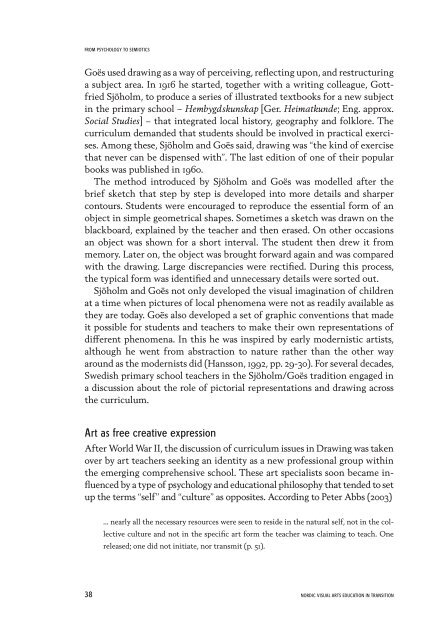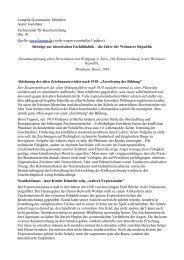Research in Visual Arts Education - The National Society for ...
Research in Visual Arts Education - The National Society for ...
Research in Visual Arts Education - The National Society for ...
You also want an ePaper? Increase the reach of your titles
YUMPU automatically turns print PDFs into web optimized ePapers that Google loves.
FROM PSYCHOLOGY TO SEMIOTICS<br />
Goës used draw<strong>in</strong>g as a way of perceiv<strong>in</strong>g, reflect<strong>in</strong>g upon, and restruc tur<strong>in</strong>g<br />
a subject area. In 1916 he started, together with a writ<strong>in</strong>g colleague, Gottfried<br />
Sjöholm, to produce a series of illustrated textbooks <strong>for</strong> a new subject<br />
<strong>in</strong> the primary school – Hem bygds kun skap [Ger. Hei mat kunde; Eng. approx.<br />
Social Studies] – that <strong>in</strong> te grated local his tory, geography and folk lore. <strong>The</strong><br />
curric ulum demanded that students should be <strong>in</strong>vol ved <strong>in</strong> practical exercises.<br />
Among these, Sjö holm and Goës said, draw <strong>in</strong>g was “the k<strong>in</strong>d of exercise<br />
that never can be dis pens ed with”. <strong>The</strong> last edition of one of their popular<br />
books was published <strong>in</strong> 1960.<br />
<strong>The</strong> method <strong>in</strong>troduced by Sjöholm and Goës was modelled after the<br />
brief sketch that step by step is developed <strong>in</strong>to more details and sharper<br />
contours. Students were en cour aged to reproduce the essential <strong>for</strong>m of an<br />
object <strong>in</strong> simple geometrical shapes. Some times a sketch was drawn on the<br />
blackboard, expla<strong>in</strong>ed by the teacher and then erased. On other occa sions<br />
an object was shown <strong>for</strong> a short <strong>in</strong>terval. <strong>The</strong> student then drew it from<br />
memo ry. Later on, the object was brought <strong>for</strong>ward aga<strong>in</strong> and was compared<br />
with the draw<strong>in</strong>g. Large dis crepan cies were rectified. Dur<strong>in</strong>g this process,<br />
the typical <strong>for</strong>m was identified and unne ces sary details were sorted out.<br />
Sjöholm and Goës not only developed the visual imag<strong>in</strong>ation of children<br />
at a time when pictures of local phenomena were not as readily available as<br />
they are to day. Goës also developed a set of graphic conventions that made<br />
it possible <strong>for</strong> stu dents and teachers to make their own representations of<br />
different phenomena. In this he was <strong>in</strong>spired by early modernistic artists,<br />
although he went from abstraction to nature rath er than the other way<br />
around as the modernists did (Hansson, 1992, pp. 29-30). For several decades,<br />
Swedish pri mary school teachers <strong>in</strong> the Sjöholm/Goës tradition engaged <strong>in</strong><br />
a discussion about the role of pictorial representations and draw<strong>in</strong>g across<br />
the curriculum.<br />
Art as free creative expression<br />
After World War II, the discussion of curriculum issues <strong>in</strong> Draw<strong>in</strong>g was taken<br />
over by art teachers seek<strong>in</strong>g an iden tity as a new professional group with<strong>in</strong><br />
the emerg <strong>in</strong>g com pre hensive school. <strong>The</strong>se art spe cia l ists soon became <strong>in</strong>fluenced<br />
by a type of psycho logy and educational philosophy that tended to set<br />
up the terms “self” and “culture” as opposites. Accord<strong>in</strong>g to Peter Abbs (2003)<br />
… nearly all the necessary resources were seen to reside <strong>in</strong> the natural self, not <strong>in</strong> the collective<br />
culture and not <strong>in</strong> the specific art <strong>for</strong>m the teacher was claim<strong>in</strong>g to teach. One<br />
released; one did not <strong>in</strong>itiate, nor transmit (p. 51).<br />
38 NORDIC VISUAL ARTS EDUCATION IN TRANSITION



